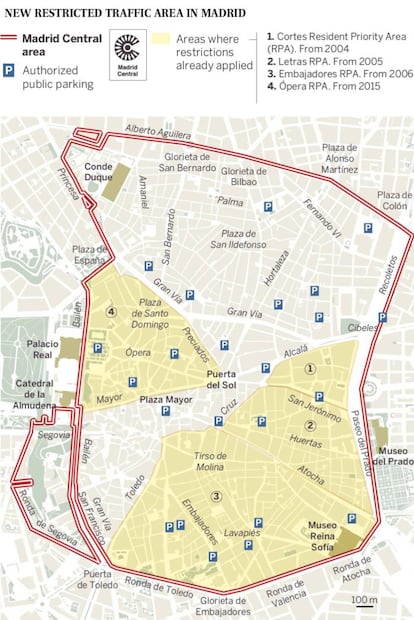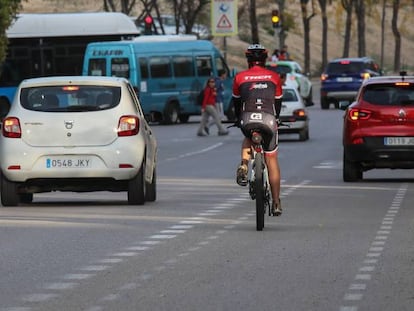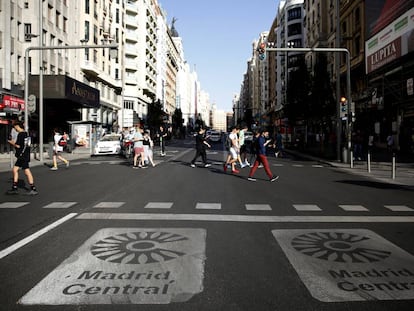Madrid Central reduces pollution by 20% in its first year
The beneficial effects of the low-emissions zone have extended to other parts of the Spanish capital


Central London restricted access to private vehicles in 2003; Berlin followed suit in 2008 and Germany now has 50 cities with similar programs. It has been exactly one year since Madrid Central, the first low-emissions zone in Spain, was introduced in the capital. In that time it has shown itself to be effective, as well as paving the way for a parallel initiative in Barcelona next year.
Despite the fact that traffic restrictions apply to an area of just five square kilometers, the effect has been felt across the city; levels of nitrogen dioxide (NO2) have fallen in 21 of the 24 air-quality monitoring stations in the capital when measured against the previous nine-year average, according to a report by the green group Ecologists in Action. In the target zone itself, the reduction has been 20%, but there are also significant drops in other areas of the city. This improvement cannot be linked to weather patterns as until November, 2019 has been the third-driest year in the last decade.
Rather than remove Madrid Central, we should leave it and add more measures
Xavier Querol, CSIC scientist
With the World Health Organization blaming pollution for more than 10,000 deaths a year in Spain, Madrid Central was introduced by former mayor Manuela Carmena on November 30, 2018. Economic fines for violations were introduced in March 2019. The zone can be accessed by residents and zero-emission vehicles, while vehicles with a B or C classification can only enter to park in a public parking lot. Vehicles with no classification are banned except when they belong to residents. The measures mean that through traffic and the oldest, most contaminating vehicles have been largely eliminated from the zone.
“Madrid has failed to meet the [stipulated] levels of NO2 since 2010, and this has been behind the threat of a fine from the European Union,” says Xavier Querol, a professor of environmental geochemical research at the Spanish National Research Council (CSIC).
This year, however, there has been a shift. Not only has the target zone’s NO2 level dropped by 20%, but areas in the vicinity have also seen a reduction: Plaza de España by 11%, the Retiro by 20% and the Paseo de la Castellana by 15%. If the current readings continue in December, most of the control stations will meet the requirements established by the EU. “The measure has triggered a reduction in traffic across the city,” says Juan Bárcena from Ecologists in Action.

Weather can also be a significant factor when it comes to pollution, with the highest readings of NO2 happening in the driest years in the past decade: 2015 and 2017. According to the Ecologists in Action report, there is a strong correlation between the worst NO2 levels and a dry year, although there are other meteorological elements to factor in, such as instability and wind. Clearly, 2019 has proven to be an exception.
Bárcena believes that the Madrid Central results have been pretty positive. “The pollution has fallen significantly in the Madrid Central zone but also across the city,” he says. “This shows that Madrid Central is a beneficial policy when it comes to improving the quality of the city’s air, although it does not solve the whole problem.” He adds that authorities need to maintain the low-emissions zone while introducing new restrictive measures in the rest of the city.
However, the introduction of complementary measures looks unlikely in the near future. The current mayor, José Luis Martínez-Almeida of the conservative Popular Party (PP), ran for office with the slogan “Madrid Central ends with Almeida.” But when he reached power with support from the far-right party Vox and the center-right Ciudadanos, his attempts to curb Madrid Central by eliminating the sanctions were thwarted when a number of judges ruled against it.
Fewer restrictions
Almeida’s idea had been to replace Madrid Central with Madrid 360, allowing vehicles with a C classification to drive through the restricted area without stopping. In the meantime, he announced plans to eliminate some bicycle lanes to give that space back to motor vehicles. The current mayor has also provoked fresh controversy by installing a vast sign in Puerta de Alcalá that reads: Madrid Green Capital – a phrase that the EU uses it to recognize cities actively fighting pollution levels.
“It’s entirely contradictory to try to demonstrate how sustainable our city is with a fictitious Madrid Green Capital sign, while announcing measures to encourage private vehicles to enter the city center, lowering the price of public parking, extend parking areas and say they are not going to restrict traffic over Christmas,” says Rita Maestre, spokeswoman for Más Madrid. “Almeida is managing Madrid Central very ideologically, which is generating a lot of chaos and uncertainty. Many people don’t know if it’s operating or not. The city council has announced a lot of things but it has not passed anything yet.”
Meanwhile the scientist Xavier Querol would like to see Madrid Central maintained and new restrictive zones added. “Madrid Central is the first measure in a Spanish city to address private vehicles,” he says. “Of course, rather than remove it, we should leave it and add more measures.” Querol suggests introducing less-stringent restrictive zones, covering an area of at least 200 square kilometers.
English version by Heather Galloway.
Tu suscripción se está usando en otro dispositivo
¿Quieres añadir otro usuario a tu suscripción?
Si continúas leyendo en este dispositivo, no se podrá leer en el otro.
FlechaTu suscripción se está usando en otro dispositivo y solo puedes acceder a EL PAÍS desde un dispositivo a la vez.
Si quieres compartir tu cuenta, cambia tu suscripción a la modalidad Premium, así podrás añadir otro usuario. Cada uno accederá con su propia cuenta de email, lo que os permitirá personalizar vuestra experiencia en EL PAÍS.
¿Tienes una suscripción de empresa? Accede aquí para contratar más cuentas.
En el caso de no saber quién está usando tu cuenta, te recomendamos cambiar tu contraseña aquí.
Si decides continuar compartiendo tu cuenta, este mensaje se mostrará en tu dispositivo y en el de la otra persona que está usando tu cuenta de forma indefinida, afectando a tu experiencia de lectura. Puedes consultar aquí los términos y condiciones de la suscripción digital.
More information
Archived In
Últimas noticias
How Japan is trying to avert ‘digital defeat’
From digital curfews to blocking apps: How technology experts protect their children online
Why the price of coffee has skyrocketed: from Brazilian plantations to specialty coffee houses
Confined to a Cuban hospital: When electricity is a matter of life or death
Most viewed
- Pablo Escobar’s hippos: A serious environmental problem, 40 years on
- Reinhard Genzel, Nobel laureate in physics: ‘One-minute videos will never give you the truth’
- Why we lost the habit of sleeping in two segments and how that changed our sense of time
- Charles Dubouloz, mountaineering star, retires at 36 with a farewell tour inspired by Walter Bonatti
- The Florida Keys tourist paradise is besieged by immigration agents: ‘We’ve never seen anything like this’










































